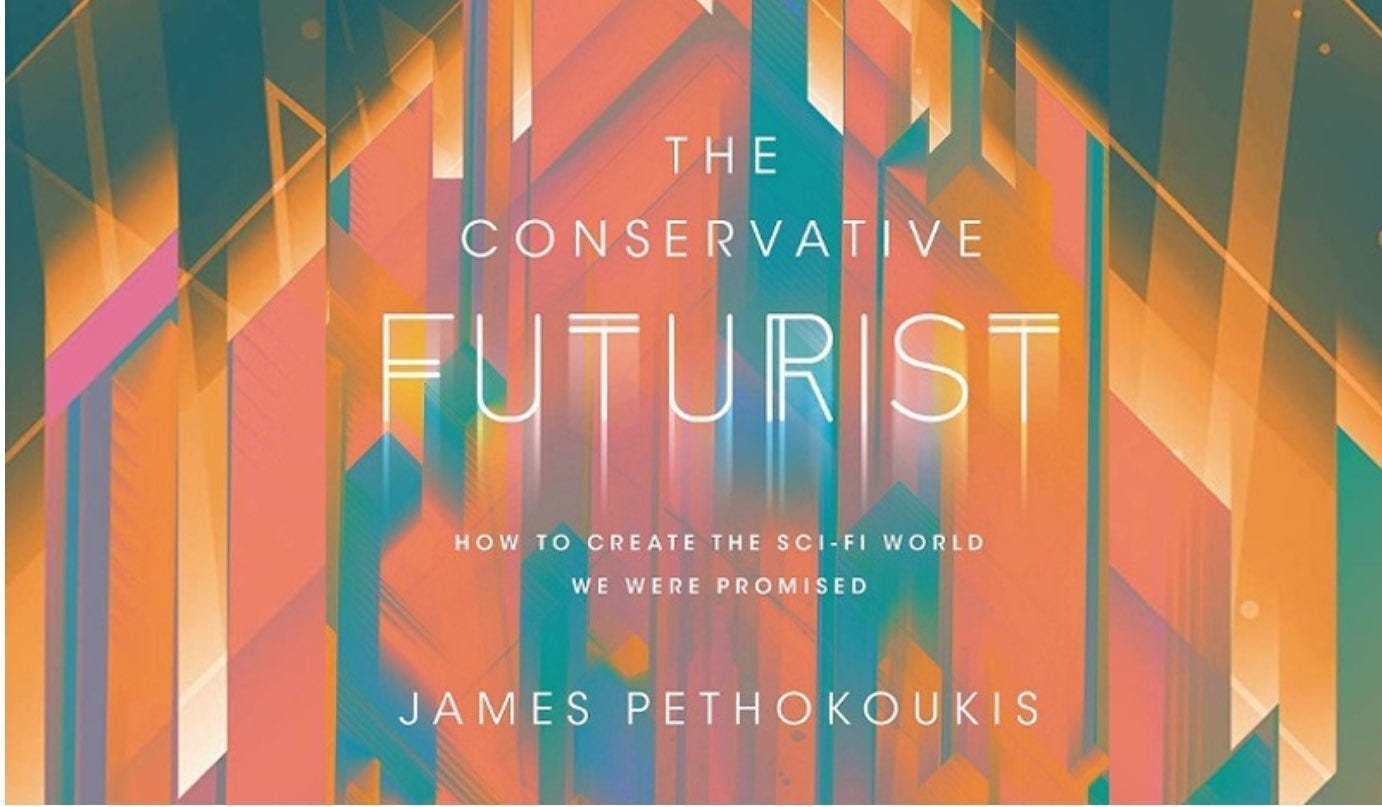🏙🔎 America’s missing megalopolis mystery (Throwback Thursday)
What happened to the supercities of BosWash, ChiPitts, and SanSan that never were?
I published a previous version of this piece on August, 19, 2024.
My fellow pro-growth/progress/abundance Up Wingers,
As I write in my 2023 book, The Conservative Futurist: How To Create the Sci-Fi World We Were Promised, “America’s cities are the economy’s high-productivity engines. They’re also where wages are highest.”
Alas, restrictive zoning and land-use regulations have artificially limited housing supply, making these cities unnecessarily expensive. This has disrupted the historical American pattern of people moving to areas with better job opportunities and becoming more productive. Economists argue that major productive cities like San Francisco should be way more populous.
“An economy like that of San Francisco should be able to support a city the size of Shenzhen, with 23 million people,” says one economist I quote in the book. “But the Bay Area today is barely able to house seven to eight million people … The movement toward large cities has become impossible due to a lack of proper infrastructure and a severe housing shortage.”
Relaxing housing regulations in high-productivity cities could significantly boost US GDP and worker earnings. (Regulatory costs in home building have increased substantially in recent years, adding to housing prices.) Many of these NIMBY regulatory barriers were erected during America’s 1970s Down Wing shift. Without them, America might well have a richer and more productive economy.
America would look different, too, with a different geographic distribution of its population. In the 1960s, Jean Gottmann, a French geographer, introduced the urban concept of “megalopolis" in his 1961 study of the northeastern United States. (I don’t think the recent Francis Ford Coppola film Megalopolis has much to do with the idea.) Gottmann identified a vast, interconnected urban region stretching from Boston to Washington D.C., characterized by dense population, economic integration, and shared infrastructure. Gottmann's work highlighted the emergence of large-scale urban systems that transcended traditional city boundaries. Welcome to the Acela Corridor.
Back then, that northeastern megalopolis was given the name “BosWash” by futurist Herman Kahn (who figures prominently in my book) in his 1967 book, The Year 2000: A Framework for Speculation on the Next Thirty-Three Years, although Kahn offered the alternative of “Portport” given that “this megalopolis really stretches from Portland, Maine, to Portsmouth, Virginia.”
By the turn of the millennium, Kahn thought BosWash would be one of at least three American megalopolises housing a massive chunk of the US population, along with “ChiPitts” and SanSan.” From Kahn’s Year 2000:
ChiPitts is another developing megalopolis, concentrated around the Great Lakes, which may stretch from Chicago to Pittsburgh, and possibly also north to the Toronto region of Canada, thereby including Detroit, Toledo, Cleveland, Akron, Buffalo, and Rochester. The United States portion of this megalopolis seems likely to contain more than one-eighth of the United States' population (or upward of forty million people). SanSan would be a Pacific megalopolis that would presumably stretch initially from San Diego to Santa Barbara, and ultimately from San Francisco to Santa Barbara, and should contain one-sixteenth or so of the United States' population (perhaps twenty million people). … Such structures will be typical of other countries as well. Thus most of southeastern England is likely to be one megalopolis, though in this case it may be called a conurbation. Doubtless the Japanese will want to find a word for the Tokyo-Osaka strip. Most people in the world, however, will still live in more traditional urban areas. Yet most of the developed world's population, perhaps 80 or 90 per cent, will be urbanized by the end of the century. This trend clearly must level-off, if for no other reason than that virtually all the people will have been urbanized. Suburbia, then as now, will be a special kind of low-density urban living, easily distinguished from rural patterns.
So, Kahn thought that half of the US population would live in those three megalopolises — BosWash (80 million), ChiPitts (40 million), and SanSan (20 million) — by 2000 versus 36 percent when he wrote the book. Yet even by 2010, that forecast still hadn’t panned out. In fact, a slightly smaller share of Americans live in those regions overall than back in the 1960s, as seen in the following chart:
Among the reasons that Kahn’s megalopolis scenario has fallen short, according to Population Reference Bureau:
Since the 1950s, the U.S. population has shifted southward and westward. The South now leads in population, followed by the West, Midwest, and Northeast. The West surpassed the Midwest in 2010 and the Northeast in 1990.
As manufacturing declined, Rust Belt cities in the Northeast and Midwest lost population to job-seeking migration. Many ChiPitts metro areas, including Detroit, Buffalo, Cleveland, and Pittsburgh, have experienced high out-migration rates since the 1970s.
The fastest growth has occurred mainly outside the three megalopolises, primarily in Southern and Western suburbs. Rapidly expanding areas include Orlando, the “Research Triangle” area of North Carolina, and regions around Las Vegas, Atlanta, and major Texas cities. Northern Virginia's exurbs near Washington, D.C. are also a notable exception within BosWash.
Population aging has driven growth in retirement destinations, often located outside the three metropolises. During the 2000s, one-third of retirement counties grew at least twice the national average. Large, fast-growing retirement areas include Maricopa County and Clark County, Nevada.
Missing from that explanation, however, is the impact of increasingly restrictive land-use regulation that raises the cost of housing in coastal cities such as New York, Boston, and San Francisco. As economist Enrico Moretti explained in a 2017 New York Times op-ed:
Look at Silicon Valley. It has some of the most productive labor in the nation, and some of the highest-paying jobs, but remarkably low density because of land-use regulations. Surface parking lots, one-story buildings and underutilized plots of land are still remarkably common because of increasingly draconian zoning restrictions. Building anything taller than three stories, even on empty lots next to a train station, draws protests from homeowners. And once a project is approved, it faces an endless series of appeals and lawsuits that can add years of delay. Appeals are remarkably easy and affordable to file and can be done anonymously. This basically gives every neighbor a veto over every new project, regardless of how desirable the project might be. It’s as if BlackBerry had veto power over whether Apple should be allowed to sell a new iPhone.
As some Silicon Valley denizens contend, it’s utterly amazing and demoralizing that the Bay Area hasn’t become the techno-Florence of the 21st Century — but with more density and better pro sports teams than the Italian Renaissance city.
Certainly public and political awareness of the housing issue has increased in recent years, both due to increased economist research, YIMBY activism, embryonic legislative pushback, and the post-pandemic surge in mortgage rates. The Harris campaign effort is another step forward in making housing a first-tier public policy issue — which it definitely should be, across the political spectrum. But, you know, faster, please!
On sale everywhere The Conservative Futurist: How To Create the Sci-Fi World We Were Promised
Micro Reads
▶ Economics
AI Was Already Clouding Tech Earnings. Then Tariffs Hit. - Bberg Opinion
▶ Business
▶ Policy/Politics
Advancing Artificial Intelligence Education for American Youth - The White House
Let’s have more babies — and less of this - Wapo Opinion
▶ AI/Digital
How to keep AI models on the straight and narrow - Economist
▶ Biotech/Health
Face photo-based age acceleration predicts all-cause mortality and differs among occupations - bioRxiv
▶ Clean Energy/Climate
The Trump administration says it wants a ‘nuclear renaissance.’ These actions suggest otherwise. - Grist
▶ Robotics/AVs
Watch out, Elon Musk. Chinese robots are coming - Economist
▶ Space/Transportation
▶ Substacks/Newsletters
Age of Invention: Just Kiln Time - Age of Invention
You are the heir to something greater than Empire - Noahpinion
Entangled by Entitlements - Risk & Progress
Seven lessons from building with AI - Exponential View
The government shouldn’t tell people where to live - Slow Boring
Reinventing the Trade Deal Wheel, Only Much Worse - The Dispatch
A China Problem: When Local Officials Shift from Facilitating Growth to Generating It - Conversable Economist
Spotlight on immune aging - Ruxandra’s Substack
Finally, A Way to Measure AI Progress; Everyone's Misreading It - Am I Stronger Yet?
The decline in cancer mortality is about much more than smoking - Scientific Discovery
Robot Dexterity Still Seems Hard - Construction Physics
Robinson Crusoe or Lord of the Flies? - AI Policy Perspectives








Not for Everyone. But maybe for you and your patrons?
Dear James,
I hope this finds you in a rare pocket of stillness.
We hold deep respect for what you've built—and for how.
We’ve just opened the door to something we’ve been quietly handcrafting for years.
Not for mass markets. Not for scale. But for memory and reflection.
Not designed to perform. Designed to endure.
It’s called The Silent Treasury.
A sanctuary where truth, judgment, and consciousness are kept like firewood—dry, sacred, and meant for long winters.
Where trust, vision, patience, and stewardship are treated as capital—more rare, perhaps, than liquidity itself.
The two inaugural pieces speak to a quiet truth we've long engaged with:
1. Why we quietly crave for signals from rare, niche sanctuaries—especially when judgment must be clear.
2. Why many modern investment ecosystems (PE, VC, Hedge, ALT, SPAC, rollups) fracture before they root.
These are not short, nor designed for virality.
They are multi-sensory, slow experiences—built to last.
If this speaks to something you've always felt but rarely seen expressed,
perhaps these works belong in your world.
Both publication links are enclosed, should you choose to enter.
https://tinyurl.com/The-Silent-Treasury-1
https://tinyurl.com/The-Silent-Treasury-2
Warmly,
The Silent Treasury
Sanctuary for strategy, judgment, and elevated consciousness